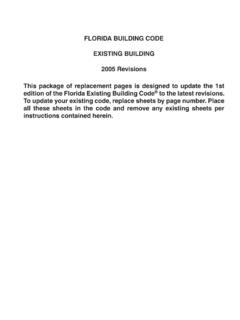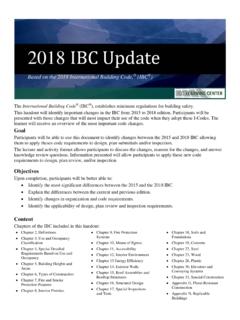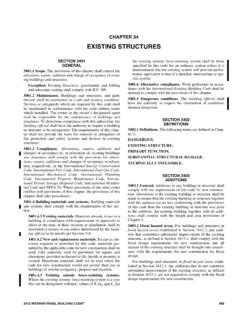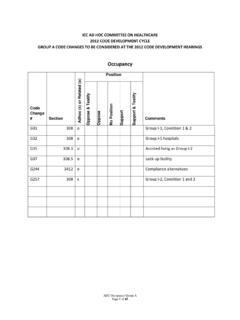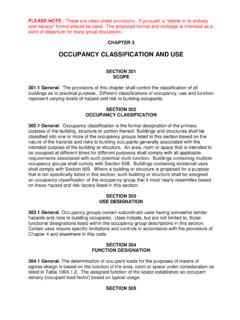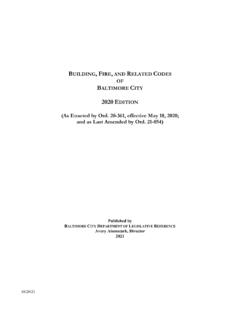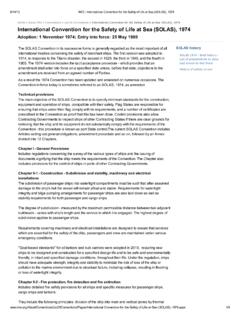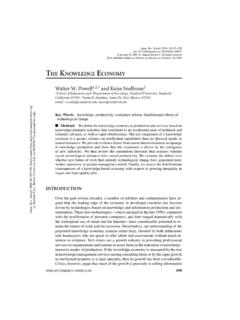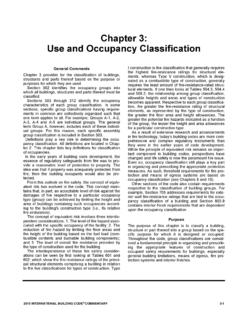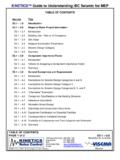Transcription of 2018 IBC Mixed Occupancies
1 2018 IBC Mixed Occupancies Copyright 2019 International Code Council12019 ICC Annual ConferenceEducational Sessions Handout2018 IBCM ixed Occupancies2018 IBCM ixed OccupanciesBased on the 2018 International Building Code (IBC )Concept of Mixed OccupanciesConcept of Mixed OccupanciesModule 132018 IBC Mixed Occupancies Copyright 2019 International Code Council22019 ICC Annual ConferenceEducational Sessions HandoutDefinitionDefinition A Mixed -occupancy condition occurs where two or more distinct occupancy classifications are determined to exist in the same building. Under such circumstances, the designer has available several different methodologies in Section 508 to address the Mixed -occupancy building. Compliance with at least one of the methods is mandatory.
2 2018 IBC Mixed Occupancies4 Use vs. OccupancyUse vs. Occupancy Use and Occupancy are terms that differ in meaning and application within the IBC. Use describes the activity that occurs within the space, room or building. Use is seldom utilized in the IBC as the scoping mechanism. Examples include occupant load calculation and incidental uses. Occupancy describes the specific classification a use is assigned when applying the code to a space, room or building. Almost all code provisions with application only to a limited number of situations are regulated by Occupancy . Primary examples include allowable height and area, fire protection features and means of egress IBC Mixed Occupancies5 General ProvisionsSection General ProvisionsSection Three options established in Section 508 to address Mixed -occupancy buildings include: Accessory Occupancies .
3 Nonseparated Occupancies . Separated Occupancies . Methods for determining maximum allowable size, height and area and separations are identified for each option. One of the three options must be applied to a Mixed -occupancy IBC Mixed Occupancies62018 IBC Mixed Occupancies Copyright 2019 International Code Council32019 ICC Annual ConferenceEducational Sessions HandoutOccupancy ClassificationOccupancy ClassificationModule 27 Classification of OccupanciesSection 302 Classification of OccupanciesSection 302 Classification is essential to the proper application of the IBC. Structure to be classified according to the function or functions for which it is intended. Buildings to be classified prior to the application of Section 508 regulating Mixed -occupancy IBC Mixed Occupancies8 Classification of OccupanciesSection 302 Classification of OccupanciesSection 302 chapter 3 provides an extensive listing of various uses and their corresponding occupancy classifications.
4 There are many special cases and exceptions. Unsure of classification? Ask for more information. If two or more distinct occupancy groups are present, the provisions of Section 508 will IBC Mixed Occupancies92018 IBC Mixed Occupancies Copyright 2019 International Code Council42019 ICC Annual ConferenceEducational Sessions HandoutGeneral ProvisionsSection General ProvisionsSection Structures are classified into one or more Occupancies in accordance with their intended uses. If the use is not specifically identified in chapter 3, it must be classified with the occupancy it most nearly IBC Mixed Occupancies10 Occupancy Classification OverviewOccupancy Classification Overview Multiple uses do not necessarily create multiple Occupancies .
5 General occupancy classification is intended to include related support areas such as corridors, stairways, restrooms, mechanical equipment rooms, small storage areas, etc. Support areas of higher hazard are often regulated as incidental IBC Mixed Occupancies11 Incidental UsesIncidental UsesModule 3122018 IBC Mixed Occupancies Copyright 2019 International Code Council52019 ICC Annual ConferenceEducational Sessions HandoutIncidental Uses ClassificationIncidental Uses Classification Occupancy classification is consistent with the general classification of the area of the building in which the incidental use is IBC Mixed Occupancies13 Incidental UsesTable 509 Incidental UsesTable 5092018 IBC Mixed Occupancies14 Foundations of the IBC for Mixed OccupanciesFoundations of the IBC for Mixed OccupanciesModule 4152018 IBC Mixed Occupancies Copyright 2019 International Code Council62019 ICC Annual
6 ConferenceEducational Sessions HandoutApplication of Mixed -Occupancy ProvisionsApplication of Mixed -Occupancy Provisions Proper application of Mixed -occupancy provisions rely on full understanding of: Occupancy classification ( chapter 3). Allowable building height ( chapter 5). Allowable building area ( chapter 5). Fire protection features ( chapter 9). Construction of fire-resistant separations ( chapter 7). 2018 IBC Mixed Occupancies16 Fire-resistance-rated Separations ScopeFire-resistance-rated Separations Scope Section 508 specifies requirements. If required, Fire Barriers per 707, Horizontal assemblies per 711, or both. Not required for: Accessory Occupancies . Nonseparated Occupancies . Certain combinations under separated Occupancies .
7 Required for: Group H Occupancies in Mixed -occupancy buildings. Certain combinations under separated Occupancies as specified in Table IBC Mixed Occupancies17 Application of the Mixed Occupancy MethodsApplication of the Mixed Occupancy MethodsModule 5182018 IBC Mixed Occupancies Copyright 2019 International Code Council72019 ICC Annual ConferenceEducational Sessions HandoutMixed Occupancies : Overview Section Occupancies : Overview Section There are four key components that regulate Mixed -occupancy buildings: Occupancy classification (includes fire protection). Allowable height. Allowable area. Separation. The three Mixed -occupancy options differ from each other based on one or more of these four IBC Mixed Occupancies19 Application of Three OptionsSection of Three OptionsSection Section mandates that one of the three options must be applied where a Mixed occupancy exists.
8 Determination of the option depends on the owner/designer. Building function. Construction costs. Design flexibility. Compliance with at least one of the three options to be verified by building IBC Mixed Occupancies20 Use of Multiple OptionsSection of Multiple OptionsSection Owner/designer may choose to use more than one option within same building. Under separated Occupancies option, relationship between multiple pairs of Occupancies should be individually IBC Mixed Occupancies212018 IBC Mixed Occupancies Copyright 2019 International Code Council82019 ICC Annual ConferenceEducational Sessions HandoutConditions Where Not ApplicableSection , ExceptionsConditions Where Not ApplicableSection , Exceptions There are three conditions under which the provisions of Section 508 do not apply: Occupancies regulated under the special provisions height and area provisions of Section 510.
9 Group H-1, H-2 and H-3 Occupancies where required to be in a detached building by Table Uses within live/work units in accordance with Section 419 (not considered as separate Occupancies ). 2018 IBC Mixed Occupancies22 Nonseparated OccupanciesNonseparated OccupanciesModule 623 Nonseparated Occupancies OverviewNonseparated Occupancies Overview Nonseparated Occupancies method considers most restrictive requirements for fire protection and allowable height/area for Occupancies involved This method beneficial to designer due to: No requirement to separate Occupancies Flexibility allowed by application of worst-case approach to fire protection and building size. No requirements for a fire-resistance-rated separation between adjacent Occupancies .
10 Nonseparated Occupancies method is most common of methods IBC Mixed Occupancies242018 IBC Mixed Occupancies Copyright 2019 International Code Council92019 ICC Annual ConferenceEducational Sessions HandoutNonseparated OccupanciesSection OccupanciesSection IBC Mixed Occupancies25 Nonseparated Occupancies : Classifications Section Occupancies : Classifications Section Occupancy classification based on the general provisions of Section Individually classified based on the use of space. Most restrictive applicable provisions of chapter 9 regulating fire-protection systems apply to the total nonseparated occupancy area, not just the specific individual occupancy, and typically address: Automatic sprinkler systems. Fire alarm IBC Mixed Occupancies26 Nonseparated Occupancies : Fire Protection Section Occupancies : Fire Protection Section IBC Mixed Occupancies27 Example2018 IBC Mixed Occupancies Copyright 2019 International Code Council102019 ICC Annual ConferenceEducational Sessions HandoutNonseparated Occupancies : Allowable Area and Height Section Occupancies : Allowable Area and Height Section The maximum allowable height and area of building is based on the most restrictive allowances for the occupancy groups under consideration.
